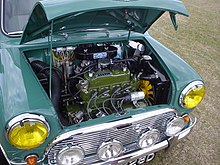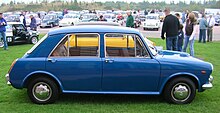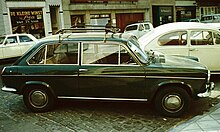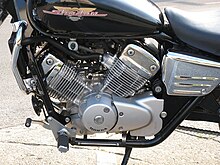Transverse engine
A transverse engine or transverse engine is in automobiles and motorcycles, an internal combustion engine whose crankshaft is mounted perpendicular to the major axis of the vehicle and parallel to the axis of the(s) drive wheel(s) of the vehicle.
History
Most front-wheel drive cars have transversely mounted inline engines, rear-wheel drive vehicles usually have front-mounted longitudinal engines. The first successful front-wheel drive, transverse-engine production car was the twin-cylinder DKW F1 series, which first appeared in 1931. After World War II, SAAB used the configuration in its first model, the Saab 92, in 1947. The configuration was also used for the Goliath brand cars, which were part of the car manufacturer Borgward Group in Bremen-Hastedt and Hansa and some other German cars. However, it was with Alec Issigonis's Mini, introduced by the British Motor Corporation in 1959, that the design gained recognition.
Transverse mounting of the crankshaft in automobiles
- Provision Issigonis: It was the pioneer system devised by the British engineer of Greek origin Sir Alec Issigonis for the Mini, it was used in many BMC models or in the first Peugeot of front traction (motor Douvrin). Unlike the Giacosa system the gearbox was integrated «in-sumption» in the engine carter under the stork sharing grease and sending some semiejes of equal length. Another feature of the system was the use of a fan following the crankshaft operated by the traditional heat clutch mechanism, which forced the radiator to be placed on the front-left fin.
- Giacosa: In the vast majority of cars with the motor tranversally located the call is used disposition Giacosa designed by the Italian engineer Dante Giacosa for the Autobianchi Primula, a system that would later be popularized by Fiat 128. In this arrangement the gearbox is independent of the engine and is also cross-sectional, with the clutch attached to the inertia steering wheel. The stand-alone mounting of the box has the advantage of separating your gear from the engine, which is convenient for the different needs of each of the systems. Its main drawback is that it forces to use semiejes of different length, so for high powers it is used to divide the longest semieje into two parts to avoid possible bandings due to the gyroscopic effect. Another typical feature of the system devised by Giacosa was the use of a radiator located its usual place on the front of the vehicle, which forced to use an electric control fan.
Transversal mounting of the crankshaft on motorcycles
In most motorcycles with 1 cylinder, or with 2 or more cylinders in line, the engine is mounted with the transversal crankshaft, since in this way the chain or band transmission is direct (without a gear to 90º). However, 90º gearing is needed for transverse engine, shaft and shaft drive motorcycles such as Harley-Davidsons, Ducatis and many recent Japanese motorcycles.
V2 Engine Transverse Mount
In a transverse V2 configuration, a narrower bike can be made since a transverse crankshaft V2 occupies the same width as a single-cylinder engine, with the advantage of better handling. A disadvantage of this configuration for air-cooled V2 engines is less cooling to the rear cylinder.
Some transverse V2s use a single carb for both cylinders, in the middle of the V. While this saves on materials, it creates additional heating problems.
- Some cooling strategies in V2 to 90° engines and transverse crankshaft
Contenido relacionado
Arquebus
Japanese Morse Code
Windows NT








